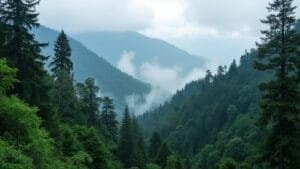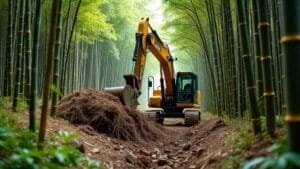Bamboo forests are the lifeline of red pandas, shaping every aspect of their ecology and survival. But what role do bamboo forests play in the habitat of red pandas? These high-altitude, temperate woodlands not only provide their primary food source—comprising up to 95% of their diet—but also serve as critical shelter and nesting grounds
Red pandas depend on the dense bamboo understory for foraging, protection from predators, and thermal insulation in the cool climates of the Himalayas. However, this deep reliance comes with risks: bamboo die-offs, habitat fragmentation, and deforestation threaten their survival
In this article, we’ll explore how bamboo forests influence red panda behavior, diet, and territorial patterns, and examine the ecological challenges that arise when this fragile habitat is disturbed. With insights from leading conservation organizations, we’ll also look at efforts underway to protect and restore bamboo ecosystems for this endangered species
Importance of Bamboo Forests in Red Panda Habitats

Bamboo forests are more than just a food source for red pandas—they form the structural and ecological foundation of their entire existence in the Eastern Himalayas and southwestern China. These temperate forests provide a microhabitat suited to the red panda’s physiological and behavioral needs, including feeding, sheltering, breeding, and thermoregulation
The strong dependence of red pandas on bamboo, both as a nutritional resource and as a physical habitat, makes these forests irreplaceable. Their unique structure—combining a dense bamboo understory with a forest canopy—supports the red panda’s arboreal and foraging behaviors, while maintaining stable temperatures and hiding spots essential for avoiding predators
This section explores how red pandas rely on bamboo forests across their range, highlighting how these ecosystems are critical to every stage of their lifecycle
Bamboo as the Primary Food Source
Red pandas are often described as bamboo specialists. Although they are members of the order Carnivora, their diet is over 90% herbivorous, and bamboo constitutes approximately 95% of what they consume daily. This reliance is a rare dietary specialization among mammals and shapes many of their behavioral and physiological adaptations
Red pandas consume young bamboo leaves, tender shoots, and stems, preferring species such as Thamnocalamus spathiflorus and Yushania maling, particularly in Nepal and India. Despite the low caloric and protein content of bamboo—approximately 20% digestibility—they manage to extract sufficient nutrients by consuming large quantities (2 to 4 pounds daily). Their molars are broad and flat, designed to crush fibrous material, while their pseudo-thumb enables them to grasp and strip bamboo efficiently
A 2015 study by Pradhan et al. in Zoological Research found that red pandas in the Kanchenjunga Conservation Area spent over 13 hours daily foraging or feeding on bamboo. Their metabolic rate is lower than similarly sized carnivores, which helps them cope with the low energy yield of their diet
Furthermore, bamboo availability dictates red panda movement. During monsoon seasons, when bamboo shoots regenerate rapidly, red pandas expand their foraging range. Conversely, during dry seasons or after flowering die-offs, they may be forced to migrate across fragmented landscapes in search of new bamboo stands, which increases their exposure to predators and human conflict
For more insights on bamboo’s role in red panda nutrition and habitat needs, visit the Red Panda Network habitat resource, which outlines the direct dependency between these mammals and bamboo ecosystems
Shelter and Nesting Functions of Bamboo Forests
Beyond their role as a food source, bamboo forests provide physical shelter and essential nesting environments for red pandas. These forests typically occur at elevations between 7,200 and 15,700 feet, where the climate is cool and the forest composition includes coniferous and broadleaved species. The understory—dominated by dense bamboo—creates a shaded, humid microclimate ideal for sheltering and hiding from predators like martens and snow leopards
Red pandas construct their nests or resting areas in tree hollows, under fallen logs, or nestled in thick bamboo patches. For mothers with cubs, the structural cover offered by bamboo provides concealment and insulation. In colder months, these dense habitats are crucial for maintaining body temperature, especially since red pandas lack body fat for insulation
A 2018 observational study in Bhutan’s Jigme Dorji National Park by Dorji et al. documented that red pandas consistently chose roosting sites within 50 feet of dense bamboo clusters. These locations offered stable microclimates, protection from wind exposure, and direct access to food without significant energy expenditure
Bamboo forests also play a key role in predator avoidance. The visual density of the bamboo understory provides camouflage, while its structural complexity creates escape routes and barriers. Red pandas are often observed resting high in trees above bamboo clusters, using the foliage below as both a cover and a quick descent route in case of disturbance
Elevational Range and Climate of Bamboo Habitats
Red pandas inhabit mountain ecosystems where bamboo forests thrive between 7,200 and 15,700 feet. These elevations present specific climatic conditions—cool temperatures (between 50°F and 95°F), high humidity, and stable rainfall—which are ideal for both bamboo growth and red panda survival. The close correlation between elevation, bamboo density, and red panda presence is evident in habitat suitability models from across their range
In a 2020 study published in Global Ecology and Conservation, Thapa et al. modeled habitat suitability for red pandas across Nepal and found that bamboo cover and elevation were the two most significant predictors of red panda presence. Bamboo forests at mid-elevations, particularly those with mixed tree canopies and high basal area, supported the highest population densities
At higher elevations, bamboo species become sparser and more prone to climate-induced die-offs. Conversely, at lower elevations, rising temperatures and human encroachment reduce bamboo viability. This altitudinal limitation creates a narrow ecological band within which red pandas can thrive—making habitat conservation in these zones critically important
The microclimatic buffering provided by bamboo forests helps red pandas cope with extreme seasonal variation. During cold months, the bamboo canopy traps heat and retains moisture, reducing thermal stress. In summer, the dense foliage provides shaded areas that help red pandas avoid overheating—a concern even in temperate climates due to their thick fur
For an ecological perspective on bamboo forests as mountain ecosystems, the One Earth article explores the symbiotic relationship between red pandas and the bamboo habitats they help maintain
Ecological and Behavioral Interactions with Bamboo

Red pandas are not only physically and nutritionally linked to bamboo forests—they are also behaviorally and ecologically dependent on the structure and life cycle of these habitats. Their movements, social behaviors, and reproductive patterns are directly influenced by the health and dynamics of bamboo ecosystems
These interactions are complex, ranging from the use of bamboo for marking territory, to being forced to migrate when bamboo populations collapse. This section focuses on how red pandas interact with bamboo in their daily routines and long-term survival strategies, revealing a deeply intertwined relationship that goes beyond feeding
Impact of Bamboo Flowering and Die-Off Cycles
One of the most significant ecological challenges for red pandas stems from the natural life cycle of bamboo species. Many bamboo varieties experience a phenomenon known as gregarious flowering, where all individuals of a species flower simultaneously over a vast area. After flowering, the bamboo plants typically die en masse, creating a sudden and severe loss of food availability
These die-offs can affect entire mountain slopes, leaving red pandas with few nutritional alternatives. Since bamboo can take years to regenerate after flowering, red pandas may be forced to travel long distances through fragmented and unsuitable habitats to locate fresh bamboo stands. This increases their risk of exposure to predators, vehicle strikes, and human conflict
A key case study from Sikkim, India (Choudhury et al., 2011), documented red panda population declines following the mass flowering and death of Yushania maling, a primary bamboo species in the region. The study found that local populations became isolated and more vulnerable due to the loss of continuous foraging corridors. In response, conservationists now monitor bamboo flowering cycles and advocate for preemptive planting of alternative bamboo species to reduce the ecological shock to red panda populations
Territorial Use of Bamboo Forests
Red pandas are solitary and territorial, and bamboo forests define the spatial boundaries of their home ranges. Individuals use scent glands on their feet and anal glands to mark trees and bamboo stalks, signaling occupancy and minimizing conflict with other pandas
These scent-marking behaviors are typically concentrated along trails that connect feeding zones and resting areas, many of which are entirely contained within bamboo-dense patches. The availability of continuous bamboo stands can determine the size of a red panda’s territory, which typically ranges from 0.5 to 1.5 square miles depending on bamboo abundance and forest connectivity
A 2021 study conducted in Bhutan’s Lamjung District found that male red pandas increased scent-marking activity during the mating season (January–March), particularly in bamboo corridors. The researchers concluded that bamboo patches serve as both communication networks and mating grounds
Territorial behaviors also influence red panda distribution across landscapes. In areas where bamboo has been degraded or fragmented by human activity, territories may overlap more frequently, potentially leading to stress or competition, especially when bamboo is in limited supply
Daily Foraging and Movement Patterns
The daily lives of red pandas are organized around bamboo availability. As crepuscular animals, they are most active during dawn and dusk, spending much of this time foraging in dense bamboo thickets. The height, density, and growth phase of bamboo strongly influence red panda movement paths and resting spots
Studies using GPS collars in Nepal’s Ilam District (WWF Nepal, 2020) showed that red pandas moved primarily along bamboo corridors, avoiding open areas and steep slopes without understory cover. On average, they travel about 1,300 to 1,800 feet per day in search of suitable bamboo stands, adjusting their routes based on seasonal bamboo growth patterns
Red pandas also display strong site fidelity—returning to known feeding patches as long as bamboo remains available. This behavior conserves energy and minimizes time spent in predator-prone areas. Bamboo forests with multi-aged stands are especially valuable, as they provide a consistent food supply through the year
In areas where bamboo is patchy or overharvested, red pandas may alter their daily routines, including resting closer to the forest floor or near human structures—behaviors that increase their vulnerability
These behavioral adjustments underscore how bamboo availability shapes every aspect of red panda ecology. The IFAW article expands on these patterns, highlighting how red pandas rely on bamboo density for both movement and survival strategy
Conservation and Threats to Bamboo Ecosystems

Because bamboo forests are critical to red panda survival, any disruption to these ecosystems has immediate and often severe consequences. These threats come from various sources, including deforestation, unsustainable land use, climate change, and lack of coordinated conservation policies. Given the red panda’s specialized habitat needs, even small-scale disturbances can lead to long-term population declines
Fortunately, multiple conservation efforts—led by NGOs, local communities, and international organizations—are working to protect and restore bamboo habitats. This section explores the most pressing threats to bamboo forests and how targeted conservation strategies are helping to mitigate these risks
Deforestation and Fragmentation of Bamboo Habitats
The leading threat to bamboo forests—and by extension to red pandas—is deforestation driven by agricultural expansion, logging, infrastructure development, and human settlement. In regions like eastern Nepal, western Arunachal Pradesh (India), and Yunnan (China), bamboo habitats have been cleared or fragmented, breaking up the continuous forest structure needed by red pandas for foraging and movement
Fragmentation not only reduces bamboo availability but isolates red panda populations into smaller genetic pools, increasing their vulnerability to disease, inbreeding, and local extinction. In addition, fragmented bamboo patches often border human activity zones, where red pandas face higher risks of poaching, dog attacks, and road mortality
According to a 2020 report by the International Centre for Integrated Mountain Development (ICIMOD), over 50% of the red panda’s natural bamboo habitat in the Himalayas has experienced degradation or loss in the past two decades, primarily due to shifting cultivation and fuelwood harvesting
These impacts are compounded by the fact that bamboo regeneration is slow and species-specific. Some bamboo types can take up to 10 years to return to usable levels after being cut, and regrowth often depends on soil quality, canopy cover, and elevation—factors disrupted by human land use
Conservation Efforts to Protect Bamboo Forests
In response to these threats, multiple conservation programs are underway to protect bamboo ecosystems for red pandas. These initiatives operate at both the local and landscape levels, targeting the root causes of habitat loss and promoting habitat connectivity
For example, the Red Panda Network has implemented the “Panchthar-Ilam-Taplejung (PIT) Corridor” in eastern Nepal, a community-based conservation area that links fragmented bamboo forests and protects over 270 square miles of red panda habitat. Local forest guardians patrol these zones to prevent illegal logging and monitor bamboo health
Similarly, Bhutan has integrated red panda habitat protection into its National Biodiversity Strategy, establishing biological corridors that connect bamboo patches across elevation gradients. These corridors are critical for enabling seasonal movement and maintaining genetic exchange
Reforestation efforts are also underway, with native bamboo species being planted in degraded zones. The One Earth Foundation’s rewilding programs in northeast India have reintroduced over 40,000 bamboo saplings to help stabilize red panda habitats
In addition to on-the-ground work, global organizations like the IUCN and WWF support research and policy advocacy to improve land-use planning in red panda range states. This includes promoting buffer zones, sustainable forestry practices, and climate-resilient habitat models
Role of Community and NGO-Based Programs
One of the most effective strategies for bamboo forest conservation has been the integration of local communities into habitat management. In red panda range countries, much of the forest land is community-managed, making local involvement essential for sustainable conservation
Organizations like Red Panda Network, WWF, and One Earth work directly with indigenous and rural communities to provide training, resources, and incentives for forest stewardship
Programs often include:
EcoGuardianship: Employing local residents as “forest guardians” who monitor bamboo growth, protect wildlife, and prevent illegal activities
Alternative Livelihoods: Offering training in beekeeping, handicrafts, or tourism to reduce dependency on bamboo and forest resources
Environmental Education: Hosting workshops and school programs that teach the ecological value of red pandas and bamboo ecosystems
For example, in Nepal’s PIT corridor, more than 100 local forest guardians have been trained, resulting in a 50% drop in illegal logging incidents between 2017 and 2022 (Red Panda Network, 2023 data). In Arunachal Pradesh, community-led bamboo nurseries provide both economic benefits and ecological restoration
These programs not only protect bamboo forests but also promote cultural ownership and sustainable cohabitation. Their success demonstrates the vital role that grassroots action plays in red panda conservation and forest ecosystem resilience. For a broader overview, the One Earth article explores how red pandas act as flagship species for bamboo forest preservation, empowering communities to lead environmental change












